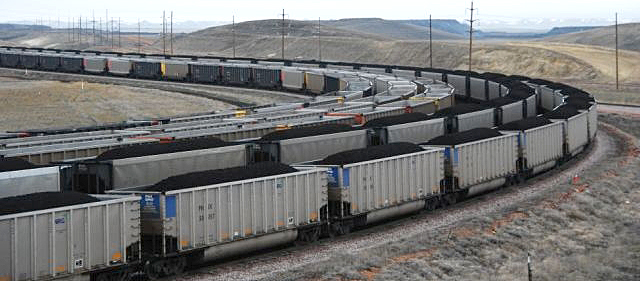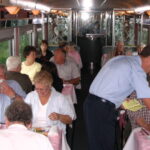Cause and Effect Could Hurt Amtrak.
Most people don’t realize that Amtrak trains run on track owned by the freight railroads everywhere in the country outside of the Northeast Corridor (Washington-New York-Boston). Amtrak pays a fee to those railroads for handling their trains, plus a little something extra for running the Amtrak trains on time.
The on-time part of that arrangement has been a real problem for a number of long-distance trains over the past several years where freight traffic has drastically increased. The most egregious example has been across the northern tier of the country along the route of the Empire Builder. The oil boom in North Dakota caused something like a ten-fold increase in the number of trains hauling crude oil to refineries around the country and the unfortunate result was the Empire Builder’s on time performance going right into the dumper.
More recently, however, as the price of oil has dropped precipitously, the Builder’s OTP has gone up and a little more than 80 percent of the trains running on time. The point here is that Amtrak trains are affected by how the freight railroads are doing.

That leads me to an interesting—not to mention worrisome—column by Fred Frailey appearing recently in TRAINS magazine. Fred points out that a great deal of coal is transported over several of the routes used by three very popular Amtrak long-distance trains. What will happen, he asks, when this country moves away from fossil fuels and some of the coal mines are closed? If, for example, the long stretches of track—miles of loops and switchbacks needed so both coal trains and Amtrak’s California Zephyr can negotiate the climb from Denver up through the Flatirons to the Moffat Tunnel and on to Glenwood Springs. If a couple of the coal mines west of Denver shut down, why would Union Pacific spend the necessary money to maintain that long stretch of track. For the Zephyr? Not hardly likely.
Fred offers two other examples—the Cardinal and the Silver Star—both trains that run on track that is heavily used by the freight railroads for transporting coal.
Just what we need, Fred. One more thing to worry about!



Why is passenger rail the only mode of transportation plagued with paying actual user fees, as Kansas, Colorado, and New Mexico were recently required to pony up to retain the “Southwest Chief” route over Raton Pass? Where is the concept of corridors and long distance routes identified as vital to national mobility and economic growth?
As coal as been so artificially diminished economically, we can only expect its resurgence with the next administration, as there are many ways to burn it cleaner that have been ignored for the “progressives” soundbite against this fuel. However, if those coal routes one-day are put up for abandonment, that is the moment for the true P3 to be implemented–public/private partnership to keep those lines open. But when will we ever succeed imposing true user fees on the airlines, trucking, buses, and autos and end their free ride on the infrastructure paid for by the taxpayer?
I am not worried. The Long-Distance network is doomed; this isn’t something to “worry” about, we have known this for a long time.
It will be up to the states to purchase and maintain the routes – as Michigan did with the Norfolk Southern route that is now the Wolverine Corridor. If they choose not to – which seems very likely in the western states – that track is gone.
Combining the Star with the Meteor just makes sense; it would result in better frequency for an entire route.
On the other hand – at least in the east where there are reasonable populations – the availability of this right of way could be an opportunity for private investment. Particularly along shorter routes that connect city pairs *and* interest with existing service such as the Meteor+Star. Once again an important thrust for inter-city rail advocates needs to be reducing the regulatory burden on rail operations and advocating for local transit as well [not last mile? you might as well not bother with inter-city]. Rail advocates too often neglect last-mile/intra-city transit; park-and-ride thinking will never deliver sustainable utilization.
In respect to Mr. Williams comments here re the future of the long distance trains, it is difficult to argue and keep a stiff upper lip. The facts are clearly irrefutable, as created by Amtrak:
1) Denigration of the dining service to a level below a coffee shop serving factories–food quality, choice, preparation; monotony of same menus every meal, every day, every train; no toasters due to uncontrollable thefts in yards; extraordinarily highly paid LSA, wait and galley staff; limited “express meals” on arrival day at end point so crew can inventory and re-pack supplies, without regard to how it further diminish the dining experience.
2) The only true first class lounge, Pacific Parlour, pulled from “Coast Starlight;” no real lounge car, but a rolling “7-11” not set-up to function as a bar/lounge.
3) No orders for replacing very worn-out Superliner consists, or, single level coaches and lounges.
4) No defense of these routes to Congress, media, and public explaining how the long distance trains serve numerous mini-markets between end points; the only transportation for many communities devoid of air and bus services; the average passengers/mile trip is equivalent now to the airlines at 800 miles; how seats/compartments turnover an average of 2.5 times en route per trip.
5) Breaking the opaque accounting system, how much of the Northeast Corridor and corporate overhead is dumped on the long distance routes? As Amtrak is not paying the infrastructure costs for these routes, as compared to the Northeast Corridor, these routes should not be so upside down and considered “dogs.”
6) Connection broken at LA between southbound “Coast Starlight” and eastbound “Southwest Chief.”
To paraphrase former Senator Moynihan, this is what we would refer to as “benign neglect” to define a deliberate corporate policy